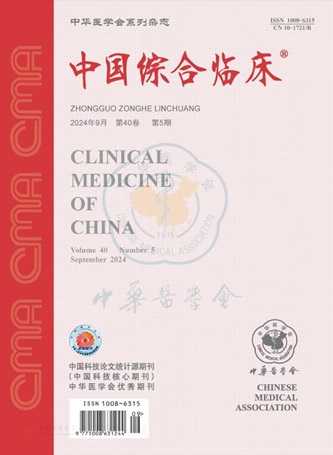5.3 mm椎间内镜微创治疗腰椎间盘突出症的安全性和有效性
引用次数: 0
摘要
目的探讨后路神经根减压术在微创腰椎间盘突出症手术中的应用价值。方法选取2016年6月~ 2018年6月云南省普洱人民医院收治的单侧单节段LDH患者80例。按随机数字表法将患者分为对照组和观察组,每组40例。对照组行后路开窗、髓核提取术,观察组行5.3 mm椎间孔后路神经松解减压术。比较两组手术切口长度、手术时间、术中出血量及术后住院时间。比较术前、术后1、2、7 d疼痛视觉模拟评分(VAS)。比较术前及术后1、3、12个月的日本骨科协会(JOA)评分和Oswestry残疾指数(ODI)问卷评分。比较两组术后12个月腰椎功能恢复情况。结果观察组切口长度、手术时间、术后住院天数、出血量分别为(0.9±0.2)cm、(50.8±8.6)min、(16.5±5.9)ml、(4.3±0.5)d,对照组分别为(4.6±0.8)cm、(72.3±15.2)min、(52.5±10.3)ml、(7.2±0.9)d。两组间差异有统计学意义(t=8.625、14.623、32.625、6.524,P均<0.001)。观察组与对照组术前、术后1、3、7 d VAS评分分别为(5.7±1.1)、(3.3±0.6)、(1.2±0.3)、(0.5±0.1)、(5.5±1.2)、(4.2±0.8)、(1.9±0.4)、(1.1±0.3)。观察组术后1、3、7 d与对照组比较,差异均有统计学意义(P<0.05)。观察组患者术前及术后1、3、12个月JOA评分分别为(8.1±1.6)分、(19.3±4.2)分、(23.2±4.9)分、(25.8±5.2)分,对照组患者术后JOA评分分别为(8.3±1.5)分、(15.2±3.3)分、(19.3±4.2)分、(20.6±5.5)分。观察组术后1、3、12个月与对照组比较,差异均有统计学意义(P<0.05)。观察组患者术前及术后1、3、12个月ODI评分分别为(43.7±10.6)分、(18.3±5.2)分、(10.2±3.9)分、(1.8±0.5)分,对照组患者术后ODI评分分别为(42.5±9.4)分、(25.2±5.3)分、(14.3±4.2)分、(4.6±0.9)分。观察组术后1、3、12个月与对照组比较,差异均有统计学意义(P<0.05)。观察组有效率显著高于对照组(92.5%(30/40)vs.75.0%(37/40), χ2=4.501,均P=0.034)。结论5.3mm椎间内镜后路神经根减压术治疗LDH患者创伤小,恢复快,安全性和疗效较好。关键词:椎间内镜;神经根减压术;腰椎间盘突出;腰椎功能本文章由计算机程序翻译,如有差异,请以英文原文为准。
Safety and efficacy of 5.3 mm intervertebral endoscopy in minimally invasive technique for lumbar disc herniation
Objective To study the application value of nerve root decompression through posterior approach in minimally invasive surgery of lumbar disc herniation (LDH). Methods From June 2016 to June 2018, 80 patients with unilateral single segment LDH were selected and diagnosed in Yunnan Puer People′s Hospital.The patients were divided into control group and observation group according to the random number table method, 40 cases in each group.The control group was treated with posterior fenestration and nucleus pulposus extraction, and the observation group was treated with posterior neurolysis and decompression through 5.3 mm intervertebral foramen.The incision length, operation time, intraoperative blood loss and postoperative hospital stay were compared between the two groups.The visual analog scale (VAS) of pain before operation and 1, 2, 7 days after operation was compared.The Japanese Orthopedic Association (JOA) score and the Oswestry disability index (ODI) questionnaire score before operation and 1, 3, 12 months after operation were compared.The effect of lumbar function recovery 12 months after operation was compared. Results The incision length, operation time, days in-hospital after operation, and bleeding amount in observation group were (0.9±0.2) cm, (50.8±8.6) min, (16.5±5.9) ml, (4.3±0.5)d, and in control group were (4.6±0.8) cm, (72.3±15.2) min, (52.5±10.3) ml, (7.2±0.9)d.The differences between the two groups were statistically significant (t=8.625, 14.623, 32.625, 6.524, all P<0.001). The VAS scores of the observation group and the control group were (5.7±1.1), (3.3±0.6), (1.2±0.3), (0.5±0.1) and (5.5±1.2), (4.2±0.8), (1.9±0.4), (1.1±0.3) before and 1, 3 and 7 days after the operation, respectively.The differences 1, 3, 7 days after operation between the observation group and the control group were statistically significant (all P<0.05). The JOA scores of the observation group were (8.1±1.6), (19.3±4.2), (23.2±4.9), (25.8±5.2) before and 1, 3 and 12 months after operation, respectively, and those of the control group were (8.3±1.5), (15.2±3.3), (19.3±4.2), (20.6±5.5) after operation.The differences 1, 3, 12 months after operation between the observation group and the control group were statistically significant (all P<0.05). The ODI scores of the observation group were (43.7±10.6), (18.3±5.2), (10.2±3.9), (1.8±0.5) before and 1, 3 and 12 months after the operation, respectively, and those of the control group were (42.5±9.4), (25.2±5.3), (14.3±4.2), (4.6±0.9) after the operation.The differences 1, 3, 12 months after operation between the observation group and the control group were statistically significant (all P<0.05). The effective rate of the observation group was significantly higher than that of the control group (92.5%(30/40) vs.75.0%(37/40), χ2=4.501, all P=0.034). Conclusion It can bring less trauma and faster recovery with 5.3mm intervertebral endoscopy by posterior approach of nerve root decompression for LDH patients, which is better safety and efficacy. Key words: Intervertebral endoscopy; Nerve root decompression; Lumbar disc herniation; Lumbar function
求助全文
通过发布文献求助,成功后即可免费获取论文全文。
去求助
来源期刊
CiteScore
0.10
自引率
0.00%
发文量
16855
期刊介绍:
Clinical Medicine of China is an academic journal organized by the Chinese Medical Association (CMA), which mainly publishes original research papers, reviews and commentaries in the field.
Clinical Medicine of China is a source journal of Peking University (2000 and 2004 editions), a core journal of Chinese science and technology, an academic journal of RCCSE China Core (Extended Edition), and has been published in Chemical Abstracts of the United States (CA), Abstracts Journal of Russia (AJ), Chinese Core Journals (Selection) Database, Chinese Science and Technology Materials Directory, Wanfang Database, China Academic Journal Database, JST Japan Science and Technology Agency Database (Japanese) (2018) and other databases.

 求助内容:
求助内容: 应助结果提醒方式:
应助结果提醒方式:


